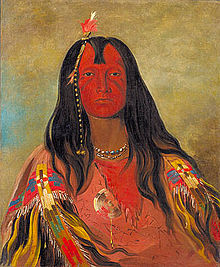
Back نيز بيرس Arabic نيز بيرس ARZ Не персе Bulgarian Nez percés Catalan Otaesétaneo'o CHY Nez Perce Czech Nez Perce Welsh Nez Percé German Nez Perce (tribo) Esperanto Nez percé Spanish
nimíipuu | |
|---|---|
 | |
 No Horn on His Head, a Nez Perce man painted in 1832 by George Catlin | |
| Total population | |
| 3,500+[1] | |
| Regions with significant populations | |
| United States (Idaho) | |
| Languages | |
| English, nimipuutímt aka Nez Perce | |
| Religion | |
| Seven Drum (Walasat), Christianity | |
| Related ethnic groups | |
| Sahaptin peoples |
The Nez Perce (/ˌnɛzˈpɜːrs, ˌnɛs-/ ; autonym in Nez Perce language: nimíipuu, meaning "we, the people")[2] are an Indigenous people of the Plateau who still live on a fraction of the lands on the southeastern Columbia River Plateau in the Pacific Northwest. This region has been occupied for at least 11,500 years.[3]
Members of the Sahaptin language group,[4] the Nimíipuu were the dominant people of the Columbia Plateau for much of that time,[5] especially after acquiring the horses that led them to breed the Appaloosa horse in the 18th century.
Prior to first contact with European colonial people the Nimiipuu were economically and culturally influential in trade and war, interacting with other indigenous nations in a vast network from the western shores of Oregon and Washington, the high plains of Montana, and the northern Great Basin in southern Idaho and northern Nevada.[6][7]
French explorers and trappers indiscriminately used and popularized the name "Nez Percé" for the Nimíipuu and nearby Chinook. The name translates as "pierced nose", but only the Chinook used that form of body modification.[8]
Cut off from most of their horticultural sites throughout the Camas Prairie[3] by an 1863 treaty (subsequently known as the "Thief Treaty" or "Steal Treaty" among the Nimiipuu),[9][8] confinement to reservations in Idaho, Washington and Oklahoma Indian Territory after the Nez Perce War of 1877, and Dawes Act of 1887 land allotments, the Nez Perce remain as a distinct culture and political economic influence within and outside their reservation.[10][11][12][13][14]
As a federally recognized tribe, the Nez Perce Tribe of Idaho govern their Native reservation in Idaho through a central government headquartered in Lapwai known as the Nez Perce Tribal Executive Committee (NPTEC).[15][16] They are one of five federally recognized tribes in the state of Idaho. The Nez Perce only own 12% of their own reservation and some Nez Perce lease land to farmers or loggers. Today, hatching, harvesting and eating salmon is an important cultural and economic strength of the Nez Perce through full ownership or co-management of various salmon fish hatcheries, such as the Kooskia National Fish Hatchery in Kooskia or the Dworshak National Fish Hatchery in Orofino.[17][18][19]
Some still speak their traditional language. The Tribe owns and operates two casinos along the Clearwater River (in Kamiah and east of Lewiston),[20][21] health clinics, a police force and court, community centers, salmon fisheries, radio station, and other institutions that promote economic and cultural self-determination.[22]
- ^ Cite error: The named reference
tribewas invoked but never defined (see the help page). - ^ Aoki, Haruo. 1994. Nez Perce Dictionary. Berkeley: University of California Press.
- ^ a b Ames, Kenneth and Alan Marshall. 1980. "Villages, Demography and Subsistence Intensification on the Southern Columbia Plateau". North American Archaeologist, 2(1): 25–52."
- ^ "Map: Distribution of North American Plateau Indians".
- ^ "Encyclopædia Britannica: Nez Perce People".
- ^ Hunn, Eugene and James Selam. 2001. Nch’i-wána, 'the Big River': Mid-Columbia Indians and Their Land. Seattle: University of Washington Press. p. 4.
- ^ "Stern, Theodore. 1998. 'Columbia River Trade Network,' Pp. 641–652 in Handbook of North American Indians: Volume 12, Plateau. Deward E. Walker, Jr., Volume Editor. Washington, DC: Smithsonian Institution."
- ^ a b Slickpoo, Allen P., Sr. 1973. Noon Nee-Me-Poo (We, The Nez Perces): Culture and History of the Nez Perces, Vol. 1. Lewiston, Idaho: The Nez Percé Tribe of Idaho.
- ^ "The Treaty Period". Nez Perce National Historical Park. National Park Service. Retrieved June 9, 2021.
- ^ "Map: Shrinkage of the Nez Perce lands after 1855".
- ^ Colombi, Benedict. 2005. "Dammed in Region Six: The Nez Perce Tribe, Agricultural Development, and the Inequality of Scale". American Indian Quarterly, 29(3&4): 560–589.
- ^ Colombi, Benedict. 2012. "Salmon and the Adaptive Capacity of Nimiipuu (Nez Perce) Culture to Cope with Change". American Indian Quarterly, 36(1): 75–97.
- ^ Colombi, Benedict. 2012. "The Economics of Dam Building: Nez Perce Tribe and Global-Scale Development". American Indian Culture and Research Journal, 36(1): 123–149.
- ^ Hormel, Leontina M. 2016. "Nez Perce Defending Treaty Lands in Northern Idaho". Peace Review: A Journal of Social Justice, 28(1): 76–83.
- ^ "Nez Perce Tribe official website".
- ^ R. David Edmunds, "The Nez Perce Flight for Justice", American Heritage, Fall 2008.
- ^ "Nez Perce Tribe Department of Fisheries & Resources Management". Archived from the original on December 26, 2018. Retrieved December 8, 2017.
- ^ Landeen, Dan and Allen Pinkham. 1999. Salmon and His People: Fish and Fishing in Nez Perce Culture. Winchester, Idaho: Confluence Press.
- ^ Nez Perce Tribe (2003). Treaties: Nez Perce Perspectives. The Nez Perce Tribe Environmental Restoration & Waste Management Program, in association with the United States Department of Energy. Lewiston, Idaho: Confluence Press.
- ^ Abrams, Joan (August 21, 1996). "Casino countdown is on". Lewiston Morning Tribune. (Idaho). p. 1A.
- ^ Tuchscherer, Tara (March 10, 1998). "Nez Perce at a crossroads (part 2)". Lewiston Morning Tribune. (Idaho). p. 1A.
- ^ "Official Home of the Nez Perce Tribal Web Site". www.nezperce.org. Retrieved December 20, 2017.